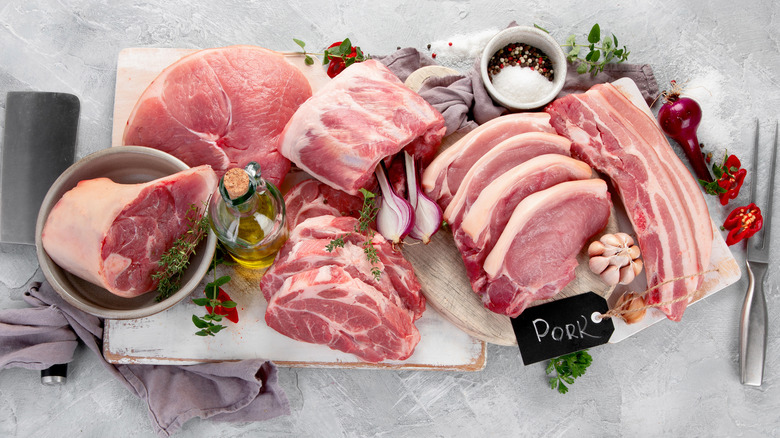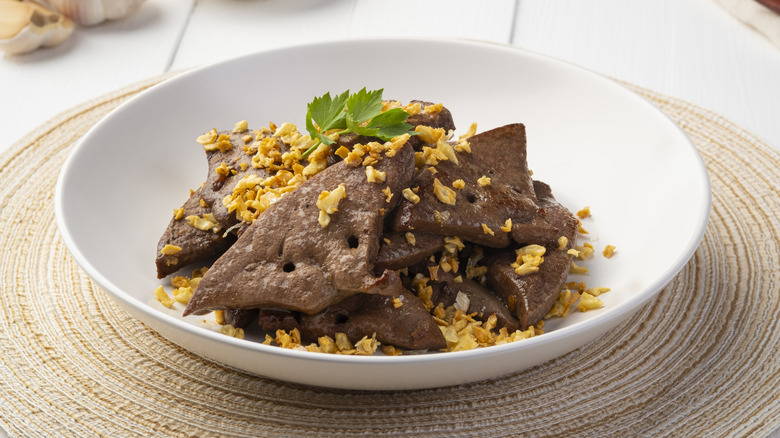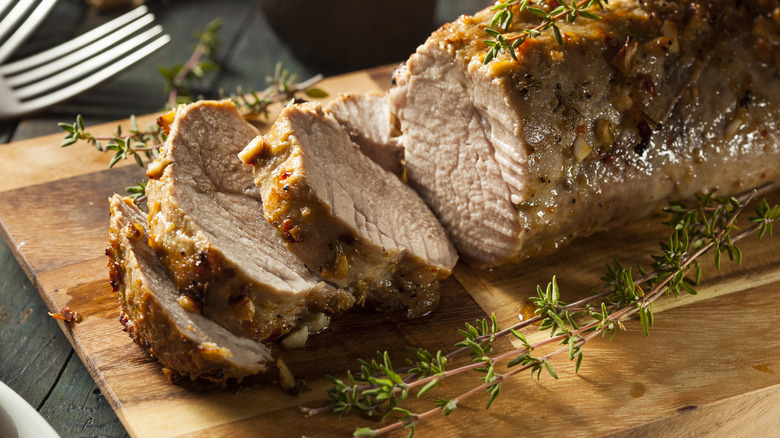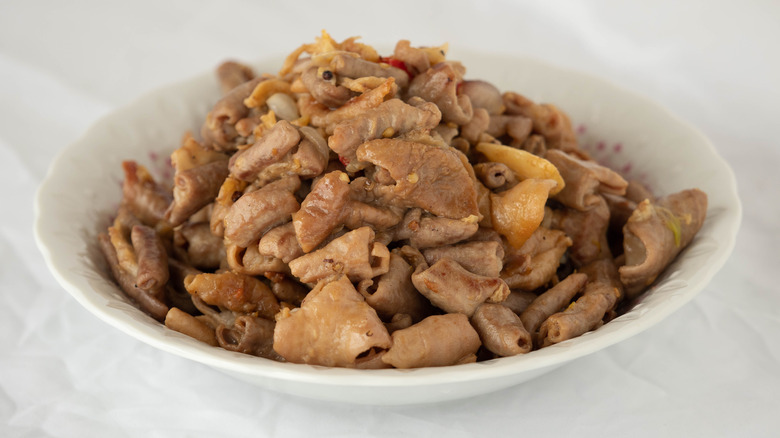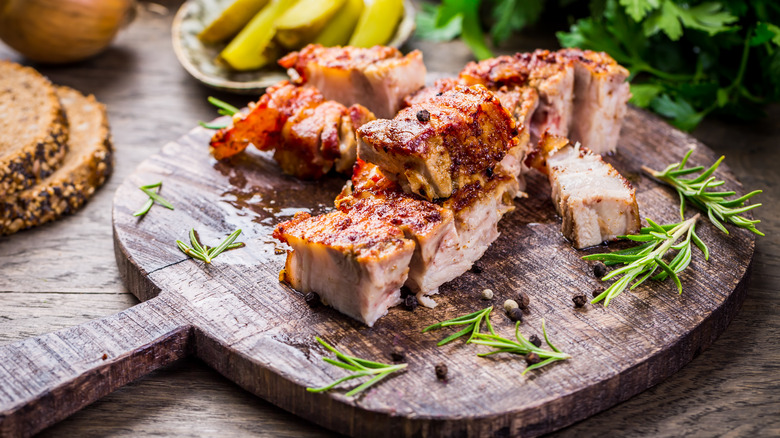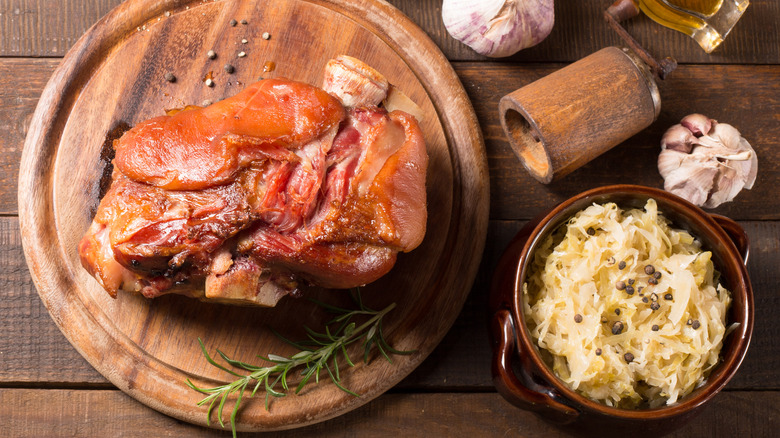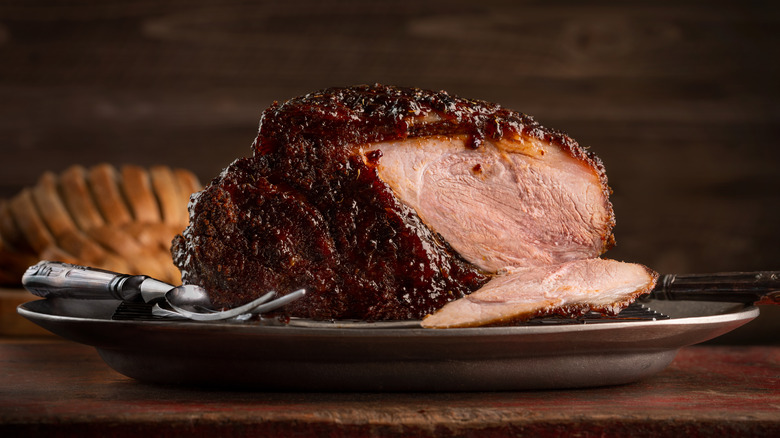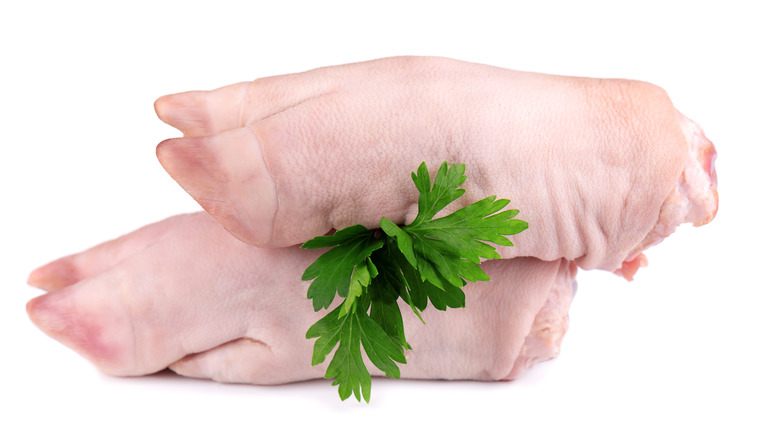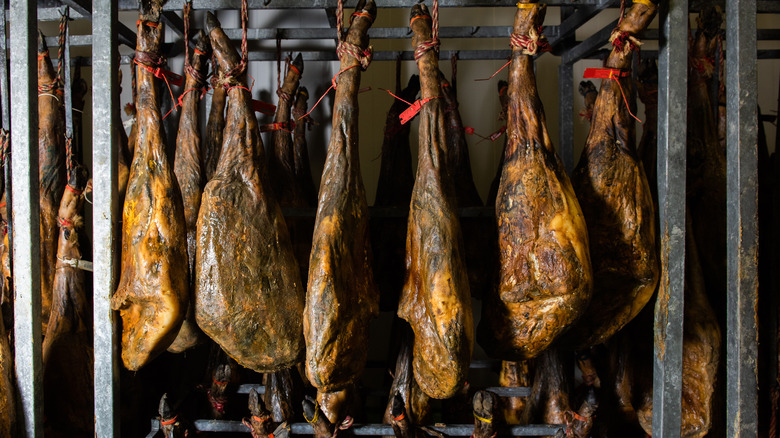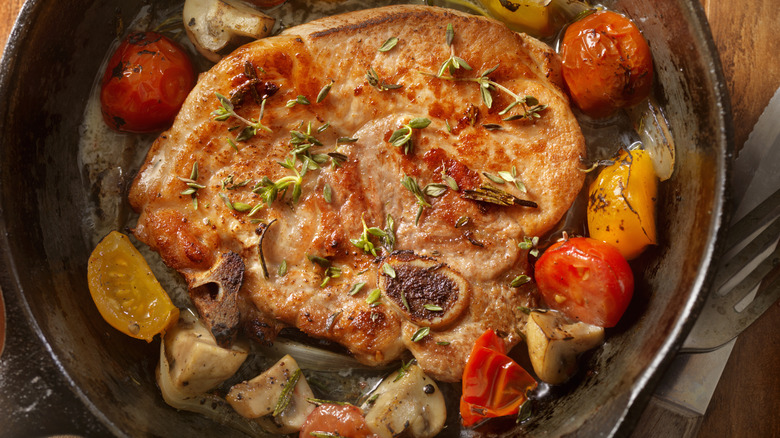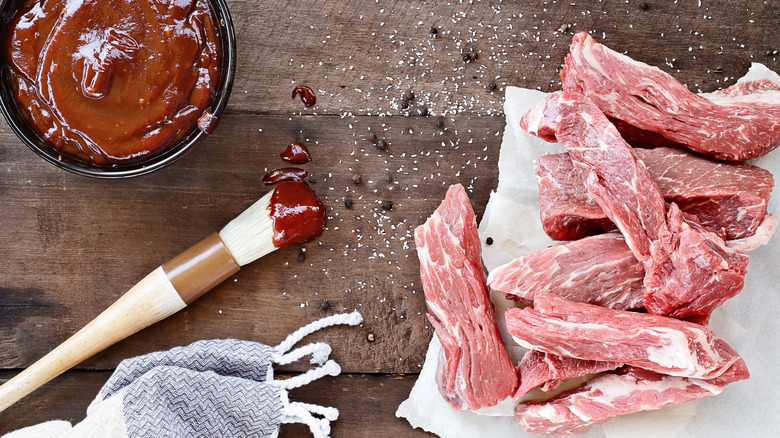5 Best And 5 Worst Cuts Of Pork You Can Buy
The culinary world is a constantly fluctuating place. But some truths remain eternal, and one of them is that pork is absolutely delicious. Whether it's been smoked, cured, roasted, brined, grilled, baked, or processed in some other manner, we just can't get enough of the noble pig's irresistible meat. But, as every carnivore knows, not all pork is created equal. Different cuts of pork have different strengths, and they can vary widely.
Some pork cuts, like the animal's liver, leave a diner chewing miserably dry mouthfuls of vaguely pork-flavored mush. Others, like country ribs, are so delectable, they prompt a person to wonder why we ever bother eating anything else. There are dozens of pork cuts in the world — some of which are downright obscure — and each has its own unique virtues, hazards, and weaknesses. How's a chef supposed to know which cuts to seek out and, just as importantly, which cuts they should avoid? We're here to help. These are the five best cuts of pork you can buy, and the five worst.
10. Worst: Liver
Like so many offal meats, pork liver is absolutely packed with vitamins and minerals ... and eschewed by a wide swath of diners. This wasn't always true: Humans have been eating offal for thousands of years, in a wide variety of cultures and regions of the world. Liver recipes are thick on the ground, and the unique meat remains beloved by many. But, plenty of modern eaters just can't bring themselves to dig into another animal's organs. In some cases, this is a real shame. Not when it comes to pork liver, however. Simply put, the liver is one of the least appetizing parts of the pig.
The existence of foie gras and deli-style chopped chicken livers might have you assuming pork liver is rich, meaty, and sumptuous. Not so. Unlike those top-dollar delights, pork liver is tough and dry, with a brutal tendency to become coarse at the slightest mishandling. Its greatest sin is that it's incredibly easy to overcook, leading to rough and crumbly mouthfuls no sauce or spice blend can save. Most frustratingly of all, it has a sweaty, acrid, funky taste, like mystery meat that spent months in the back of the freezer before being plopped into boiling water. Granted, pork liver boasts a milder flavor than beef liver, but that's not saying much. If you want to eat liver, choose one from another animal. If you want to eat pork, choose another cut. Pork liver just isn't worth the trouble.
9. Best: Tenderloin
The tenderloin cut lives up to its name: This is a succulent, versatile, and incredibly tender cut of pork. While many people confuse it with pork loin, it's not the same thing; tenderloin is taken from the long, narrow muscle that runs along the pig's backbone. This isn't an area that undergoes a ton of strenuous activity, which results in the cut's decadent texture and uniquely lean fat content.
As seasoned chefs might already guess, this skimpy fat quotient keeps the tenderloin cut from reaching the heights of rich, moist, pork-y flavor. That might seem like a major flaw but, in fact, this is a virtue. If you're open to it, pork tenderloin's delicate taste is a delight unto itself and especially well-suited to lighter, hot-weather dishes. Moreover, this cut soaks up marinades, sauces, glazes, and condiments like a sponge. This makes the tenderloin cut an especially good choice for bold and experimental chefs looking for an ideal canvas upon which to try out an outré blend of herbs, juices, spices, or whatever else might come to mind. Because of its luscious texture, pork tenderloin is also well-suited to quick cooking. It's the cut to choose if you're looking to make a pork-centric stir fry, top a pork roast with an exotic salsa, or quickly sear a tasty hunk of meat in a trusty skillet.
8. Worst: Chitterlings
Pork intestine, otherwise know as chitterlings or chitlins, have made a major cultural mark. They pop up in "Tess of the D'Urbervilles," are a soul food staple, and even played a major role in American music history through the legendary Chitlin' Circuit. A heroic amount of work goes into preparing them for consumption: They have to be soaked, washed, and rinsed until they're squeaky clean, a process that can take hours. And that's just the beginning — breading, frying, or stewing them is a whole 'nother affair. If you want chitterlings, you're going to have to sweat for them.
Sadly, all the work in the world can't make chitterlings into a great cut of pork. First off, there's the odor. They're intestines, and they smell like it. This scent tends to persist through much of the cleaning process, and sometimes simply refuses to go away, no matter how much rinsing has taken place. The taste and texture don't make up for these flaws, either. The worst chitterlings taste like they smell, which makes the diner feel a little bit like their eating next to a barnyard. The best chitterlings are a definite improvement, but not an unqualified success — they're meaty, but often in an uninteresting way. Texture-wise, chitterlings tend to be rubbery. Some people might enjoy this — they'd probably call them "chewy," though — but many find it unpleasant. We respect what chitterlings have done for the world, but we simply don't want to eat them.
7. Best: Belly
We can't be sure, but we're willing to bet that pork belly is impossible to dislike. This fat-rich cut is an absolute all-star. Taken from — you guessed it – the belly of the pig, pork belly comes in many forms, all of them delicious. Most bacon and pancetta are made from pork belly. It's the backbone of a wide variety of iconic pork dishes from all around the world, including German schlachtplatte, Korean samgyeopsal, and Filipino lechon kawali. Wherever pork is eaten, everyone agrees: No one can resist pork belly's charms.
This cut's richness is its most obvious virtue, but it's not the only one, as it's also impressively versatile. As bacon and pancetta, it can be enjoyed on its own, tossed with pasta, added to soups, or sprinkled atop all manner of vegetables to give them a savory kick. It can be roasted, seared, breaded, stewed, or fried — and that's just a small sampling of preparation options. Sweet glazes play beautifully off its decadent flavor, acidic marinades bring out its savory notes, and zingy herbs achieve new heights when subsumed within its rendered fat. There's really only one way to treat pork belly badly, and it's all down to the fault of the diner, rather than the cut itself: Overeating pork belly is a great way to give yourself a stomachache. But really, who could blame you if you did? Pork belly isn't just delicious — it's pretty much irresistible.
6. Worst: Shanks
As chefs familiar with beef shanks have probably already guessed, pork shanks are basically the pig's ankle. This is the kind of cut many epicures insist is delicious if it's cooked right, and they're not entirely wrong. If prepared by a skilled chef who allows them to cook low and slow for a significant length of time, pork shanks can be tasty. A long braise infuses them with flavor and tenderizes them into something luscious and fork-able. Not a bad outcome by any stretch of the imagination — in fact, that sounds downright divine.
But, if even one thing goes wrong, pork shanks transform into a tough, dry misery of a meal. Hold on, you might reply, that can be said about all meats! Technically true — but the latter experience is the dominant one when it comes to eating pork shanks. This is an incredibly unforgiving cut, which magnifies every single slip-up. Even if you do everything right, there's a good chance you'll end up with tasteless leather — and, as a bonus, brain-wracking frustration as you futilely try to figure out what went wrong. Maybe you left them in for 10 minutes too long. Maybe your marinade wasn't acidic enough to break down the cut's tough connective tissue. Maybe your butcher made an imprecise cut. You'll never know! Pork shanks should only be attempted by people with a healthy sense of self-forgiveness and a solid dinner backup plan in place.
5. Best: Boston butt
We know what you're thinking: Boston butt must come from the pig's hindquarters. In fact, this legendary cut is taken from the pig's shoulder. Confusing, right? But this linguistic mix-up might just be this cut's only flaw. Boston butt is the source of some of the greatest pork dishes ever conceived by man.
This cut is full of connective tissue, which means it requires a little more processing than other cuts to become succulently tender. Typically, chefs cook it over a low flame for a long period of time. Because the cut is also beautifully marbled with fat, once it's done cooking, it's become a tender, luscious, deeply flavored dream of a dish. Moreover, it's pretty darn difficult to overcook, which makes it fabulously forgiving and well-suited to parties where multitasking is the order of the day.
Boston butt is also fantastically adaptable. You can roast, sear, grill, smoke, and braise it, slice it into medallions, shred it with a fork, mingle it with thick sauces, pile it high in sandwiches, and fry its tender morsels until they're crisp little nuggets. Hungry for carnitas? This is the cut you're looking for. Looking to blow your friends' minds with the greatest pulled pork sandwiches they've ever had? Reach for the Boston butt. It's flavorful. It's forgiving. It's just about as versatile as a cut can be. In short, it's pork at its best.
4. Worst: Trotters
Trotters are, as you might expect, pig's feet. You might balk at this — pigs do spend an awful lot of their time trudging through infamously grungy styes, after all — but in fact, this isn't the problem with trotters. They undergo a significant amount of processing on the road to consumption: Any butcher worth their salt will make sure that the animal's hairs have been pulled, its skin has been scrubbed, and all dirt has been carefully extricated from the crevice between the pig's two digits. All that work must be worth it, right? Well ... not so much.
Trotters do have some things going for them, being rich with collagen and impressively flavorful. If you toss them into a stew, you're going to end up with a decadent and silky base of pure pork goodness. But, as a cut of meat eaten unto itself, they leave a lot to be desired. First off, between the skin and bones, they don't actually contain much meat. What meat there is also requires a whole lot of low, slow cooking to become palatable. Many different pork cuts need this sort of treatment, but most of them yield a whole lot more meat than the relatively piddly amount contained in a trotter. Other preparations have their virtues; pickled trotters, for example, are prized for their briny, meaty goodness in some parts of the world. But, the fact is everything that trotters do well, other cuts of pork do better.
3. Best: Ham
Don't start picturing a succulent roasted ham plastered with pineapple slices — we're talking about ham the cut, rather than ham the finished dish. Don't feel bad if we've set your head spinning; "ham" means so many different things in so many different contexts, it's hard to keep track. Here, though, we're referring to the specific cut of pork taken from the animal's hind leg.
What makes ham so great? The better question is, what doesn't? Fresh ham is a culinary powerhouse in terms of flavor, texture, and versatility. It boasts a rich, deep, truly pork-y taste some compare to pork loin, yet it's also as fatty as a slice of bacon. Looking to enjoy the fiery goodness of smoked pork? Ham takes to the process beautifully. Interested in dazzling your holiday guests with a legendary ham? A few hours in the oven transforms this cut into the stuff Christmas dreams are made of. Want to break down its delicious fat and connective tissue with a long braise? Get ready to enjoy some of the most mouth-wateringly tender meat of your life. Ham is a workhorse in the kitchen, adaptable to high-profile affairs and everyday dinners alike. Foodies who like to get their hands dirty should pay particular attention to this cut; learning to cure your own hams isn't just easy, it's immensely satisfying. You might never go back to the supermarket's ready-made versions again.
2. Worst: Sirloin chop
While other pork loin cuts are prized for their tenderness, this is absolutely not the case when it comes to sirloin chops. Sirloin chops are taken from the pig's hip, and are a whole lot bonier, tougher, and drier than their neighbors. But wait, you might be thinking, I know how to deal with that! Visions of braising, marinating, and tenderization dance in your head as you anticipate how this cut might taste with a sweet glaze, or perhaps a piquant sauce. Alas, all of your assumptions are wrong. No amount of low-and-slow cooking or condiment-slinging excellence can redeem this subpar cut because it simply doesn't taste that great.
Here's the best case scenario for the sirloin chop: After hours of careful cooking, you end up with a tender-ish chunk of pork that tastes like whatever you slapped on it. The cut's toughness is a gigantic pain, but its flavorlessness is its fatal flaw; if you do absolutely everything right, you'll still end up confronting this fact head-on. And let's be real — you're not going to do absolutely everything right. It's maddeningly easy to overcook sirloin chops, which are a tad bit thinner than many other loin cuts. This means you stand a significant chance of overshooting gloriously tender meat and ending up with a tough strip of jerky every single time you choose this cut. There's a reason Cook's Illustrated gives the sirloin chop zero stars: It's simply never worth your time, effort, or money.
1. Best: Country ribs
When you think of ribs, you think of ... well, ribs. Specifically, you probably picture tantalizingly tender hunks of meat, cooked to such perfection they barely cling to the rib bones that give them their name. While such ribs are indeed delicious, we're talking about country ribs. Country ribs are a little bit different — or a lot, depending on your rib opinions. Why? Well, they don't actually feature rib bones.
This is a bit of a curveball, we admit, but these lip-smacking strips of meat are indeed boneless, and don't actually come from the rib region: They're cut from the bulk and the blade end of the pig's shoulder. There's a small but important difference between these two locations: Country ribs taken from the bulk of the shoulder are a tad bit fattier. While this makes them especially decadent, both styles are well worth your time and money.
Country ribs are among the best cuts of pork money can buy for two major reasons: They're absolutely scrumptious and they're incredibly versatile. You can jam them onto a kebab, slather them in tangy sauce, plop them on the grill, and even braise them. No matter what, their mellow, well-balanced, deeply pork-y flavor is sure to impress. Moreover, unlike many cuts on this list, they cook quite quickly. A day-spanning roast can indeed be delicious, but there's something to say for a pork cut you can prepare on a busy weekday night.
